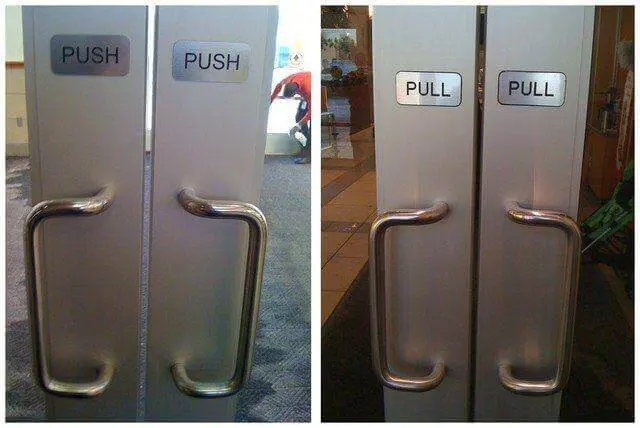

Every object or service we use is designed by someone. Even objects that you take for granted, like alarm clocks or doors, are designed by someone for someone. And often these objects take complex problems and issues and make them easy and simple to use. If we look at the design of a clock, we can see a concept abstract principle which has been organised and presented in a very clear and concise manner. The ability to glance at a clock and know what time it is an underappreciated example of excellent design.
All artificial things are designed. Whether it is the layout of furniture in a room, the paths through a garden or forest, or the intricacies of an electronic device, some person or group of people had to decide upon the layout, operation, and mechanisms.
- Donald A. Norman, The Design of Everyday Things
This age-old problem – simplifying complex actions into streamlined and simple objects – hasn’t changed as designers’ focus has shifted into the digital space. The underlying problem we’re trying to solve hasn’t changed. It could even be argued that the physical limitations that the digital space has removed have made this challenge even harder to solve.
Designers have found incredibly clever ways to solve some of these complexity issues in the digital space. Early iOS applications relied heavily on skeuomorphism to help bridge the gap between the old, physical world, and a new exciting digital world. Despite its critics (and a gradual shift to flat, ‘modern’ design) skeuomorphic design was one of the best examples of taking complex design problems and making them simple for your customer. As waves of customers learnt to use their new touchscreen devices, they immediately knew how to use the applications due to smart, customer centric design thinking.

The original iPhone was ground-breaking but leaned heavily on skeuomorphism to help ease the transition from an analogue world to a brave new digital one. It is one of the best examples of reducing the cognitive load on users.
And this thread has been an important one for digital design. Don’t make me think as a general philosophy for building intuitively designed interfaces has spawned literal books and has been a guiding tenet in UI design over the last decade. Users have come to expect certain functionality and design principles to be adhered to across brands and services; what would you expect a logo to do if you clicked on it? Focusing on not forcing customers to relearn new behaviours is a guiding principle that almost any UI designer will vouch for.
But making the complex simple is much harder to do than it sounds. Think about how many times you’ve pushed a door the wrong way? Surely if all doors were designed perfectly, you’d never question which way a door would open. Digital experiences are similar.
As customer experiences have shifted online, they’ve grown increasingly complex. Customer experiences often have competing priorities. For example, a membership organisation may want to use their website to acquire new members, whilst also making it easy for current members to login, access events and materials, or edit their payment information. Each one of these may be controlled by a separate team who are concerned about their KPIs and metrics. If done badly, this customer experience can become arduous and may ultimately prevent customers from using your service. What’s more, the delivery team will likely waste effort developing functionality which does nothing to improve your customer experience or positively affect your business’ overall goals.

Everything is designed. How many times have you expected something to work in a certain way, only to find it does something different? Should you need labels to know which way doors open? Or is this an example of poor design?
Good businesses will often find their customer feedback conflictive which, when acted upon, can result in the product trying to do too many things to satisfy everyone who uses the service. There’s a cruel irony that businesses which invest in user centric design methods, such as qualitative interviews and design testing, can often be guilty of designing at too low a level, which ends up negatively impacting on the entire customer experience.
Despite the complexity of these services increasing, we do have the ability to shape and mould them. Customer experience led design thinking allows us to create compelling experiences throughout the entirety of the customer journey. Through the constant analysis of the customer experience as a whole, and keeping the customer at the forefront of our minds when designing, we can manage this complexity and ensure that all our customers are clear on how to complete any given action.
The most important aspect to making the complex simple is understanding the root problem you’re trying to solve. This is a business fundamental, but often one that gets conflated over the lifecycle of a product or service. As businesses diversify, or certain teams face issues, the core offering that your product aims to service ends up being diluted. CX design thinking forces us to constantly assess what it is, and who it is we are building for. We must constantly evaluate whether our customers are changing, and what it is they expect our service to provide to them. Product owners and CX designers should be looking at the overall picture, and whether requested features and services are being asked to solve the core issue which all users are facing. When faced with complex design decisions and competing opinions, we must ask simple questions.
Despite their ‘This Watch Tells Time’ advert campaign for the latest Apple watch being a little tongue in cheek, it raises a serious point about concentrating on your core focus. The Apple watch does many, many things, but if it didn’t tell time, would it be achieving its core objective?
A move to evidence-based design thinking has been a trend that continues to be adopted across all industries. And whilst teams often focus on testing the visuals, it’s less common to see teams test their customer experience focus. Testing all aspects of a customer’s experience is vital to providing an online service that satisfies the desires of your customers. We often think of customers as static objects with desires and needs that may not shift at the speed we expect them too. By questioning the customer experience, we can inform the design of that experience and pivot quickly as our customers’ wants and needs change.
Many products defy understanding simply because they have too many functions and controls. I don’t think that simple home appliances—stoves, washing machines, audio and television sets—should look like Hollywood’s idea of a spaceship control room.
- Donald A. Norman, The Design of Everyday Things
Those involved in developing products and services can often be guilty of over engineering solutions to simple problems. Either through misunderstanding the customer or wanting to provide too many functions within a single screen or product, designers can often be the barrier between simplifying the complex. This is why it’s vital to completely analyse the core focus of the service you’re attempting to provide. The modern web is as guilty of this as any design discipline, with a myriad of complex pop ups, newsletter sign ups and competing priorities preventing customers from reading a simple news article. Instead, we should trust that our overall customer experience will allow us to use simple visual cues and design consistency to generate the leads needed to grow and expand a business. Too often web pages represent the internal struggles of teams and don’t deliver concisely what the user needs.
Ultimately each business has its own unique design challenges. Many of these challenges will be complex to solve but, by overseeing the entire customer experience, we can help solve these issues through answering simple questions. We must constantly evaluate what it is our customers are asking us for. We cannot create fridges which have excellent touchscreens, but do not keep our food cold. It’s the job of the CX focused designer to ensure each digital experience you’re creating fits into and solves the particular challenges of each section of your customer base without diluting the business’ core offering.
If you’d like to talk to us about streamlining your customer experience to increase revenue then get in touch, we’d love to hear from you.